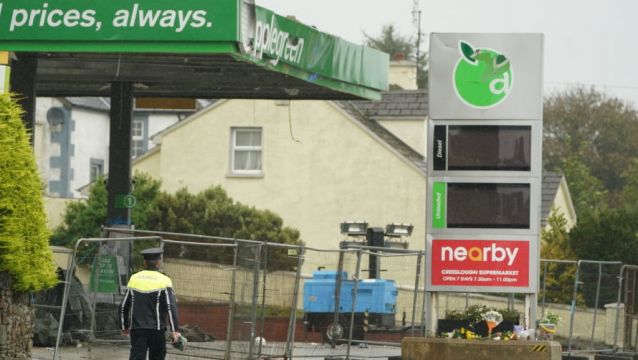A complaint about a controversial TG4 documentary on the explosion in the Co Donegal village Creeslough in October 2022 which killed 10 people has been partially upheld by the media watchdog.
Coimisiún na Meán said the documentary, Iniúchadh TG4 – An Craoslach, which was broadcast on February 8th, 2023, had breached the Broadcasting Act 2009 by causing harm/offence.
The media regulator said TG4 had not sufficiently demonstrated that it took due care in broadcasting material which could cause distress, particularly given it was shown just four months after the tragedy and before a Garda investigation into the explosion was completed.
It also ruled TG4 could have avoided causing distress to bereaved families by consulting them in advance of its transmission.
Coimisiún na Meán, which replaced the Broadcasting Authority of Ireland for overseeing complaints about TV and radio programmes, said the documentary had also breached the BAI Code of Programme Standards in relation to the requirements to take due care to ensure audiences are not exposed to harmful content.
Legitimacy
However, the regulator acknowledged the legitimacy of making and broadcasting a programme about the response of the local community in Creeslough to the explosion at a shop and petrol station in the village and the impact of the tragedy on the area.
It did not uphold complaints that the programme had breached the BAI code in relation to respect for privacy and protection of the public interest.
The complaint was made by Killian Flanagan on behalf of his sister, Áine, whose daughter, Shauna (5) and her partner, Robert Garwe (50) were killed in the blast at the Applegreen filling station on October 7th, 2022.
Mr Flanagan claimed certain aspects of the programme were distressing, particularly because the family would not have detailed information on the explosion until the Garda investigation had concluded.
He told RTÉ’s Liveline programme last February that he had asked TG4 not to air the programme while the Garda investigation into the explosion was ongoing.
Distress
Mr Flanagan said the documentary had particularly caused serious distress to his sister when an interviewee had claimed he could hear a little girl talking but was unable to get to her.
While the programme did not identify who the girl was, Mr Flanagan said his sister believed it might have been Shauna and that she might have been alive after the explosion with first responders unable to reach her.
Mr Flanagan said his sister was also contacted by friends and relatives who also thought the girl referenced in the programme might have been Shauna.
He claimed the programme caused further anguish and distress when someone described the building as collapsing “like a pancake” as such information was not previously known by his family.
Mr Flanagan pointed out that TG4 had stated in advance of the broadcast that the documentary would not report anything about the victims other than what had already been reported publicly.
Prior consultation
He also observed that the programme was made without any prior consultation with bereaved families and that TG4 had ignored his family’s request for information about the programme before it was shown on TV.
In response to the complaint, TG4 told the regulator that the decision to broadcast the programme was not taken lightly.
The broadcaster explained that the documentary was aimed at giving a voice to those who were involved in the immediate aftermath of the explosion at Creeslough, particularly those who assisted in the rescue of people trapped in the debris.
TG4 claimed that there had been what it regarded as “ill-informed and unhelpful commentary” from certain media outlets who had not sought to review the programme in advance of its transmission.
It claimed this had led to a lot of activity on social media and related distress.
TG4 also stressed that the reference to a little girl did not refer or imply in any way that it was Mr Flanagan’s niece.
It informed the regulator that it had sought and received clarification on the day after the programme was broadcast that the little girl was someone else who had been rescued.
The station said it had promptly notified Mr Flanagan of this information.
TG4 argued that most people viewing the full programme would have concluded that “a sensitive and responsible approach” had been taken throughout the documentary.
In addition, it stated that viewers were warned in advance that it contained sensitive material, while it also carried a notice at the end of the programme of contact details for a helpline for anyone affected by it.
TG4 said information in the programme about the cause of the explosion was based solely on Garda press releases and that it did not include any examination or commentary on the cause of the blast.
The broadcaster said it was satisfied that the programme was in the public interest as it was important for people to understand the wider impact of the tragedy on those in the local community who were directly involved in the rescue.
However, Coimisiún na Meán said TG4 had failed to address why the programme did not identify the little girl referenced in the programme and why it was not explained that she had survived the explosion.
The regulator said a similar story concerning a boy was also contained in the programme which clarified that he had survived.
“It is unclear why this approach was not taken in relation to the story of the little girl,” the regulator stated.
Only for the fact that the girl referenced in the broadcast was not Shauna, the regulator said it may have decided that the programme had unreasonably encroached on a person’s privacy.
It also said there was no evidence that TG4 had consulted bereaved families in the making of the programme, which could have mitigated against the possibility of it causing distress.
However, the regulator said there was editorial justification for including the observation by an eyewitness about the building collapsing like a pancake.







